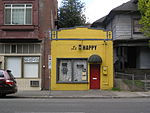Spokane, Portland and Seattle Railroad Warehouse
1908 establishments in OregonBuildings and structures completed in 1908National Register of Historic Places in Portland, OregonNorthwest Portland, OregonRailway buildings and structures on the National Register of Historic Places in Oregon ... and 4 more
Railway freight houses on the National Register of Historic PlacesRichardsonian Romanesque architecture in OregonSpokane, Portland and Seattle RailwayTransportation buildings and structures in Portland, Oregon

The Spokane, Portland and Seattle Railroad Warehouse, also known as the Christensen Electric Building, is a building located in Portland, Oregon, listed on the National Register of Historic Places. A former warehouse used by the Spokane, Portland and Seattle Railway, it has been converted into an office building. It was added to the National Register in 1996.
Excerpt from the Wikipedia article Spokane, Portland and Seattle Railroad Warehouse (License: CC BY-SA 3.0, Authors, Images).Spokane, Portland and Seattle Railroad Warehouse
Northwest Thurman Street, Portland Northwest District
Geographical coordinates (GPS) Address Nearby Places Show on map
Geographical coordinates (GPS)
| Latitude | Longitude |
|---|---|
| N 45.535958 ° | E -122.688288 ° |
Address
Northwest Thurman Street 1631
97209 Portland, Northwest District
Oregon, United States
Open on Google Maps









